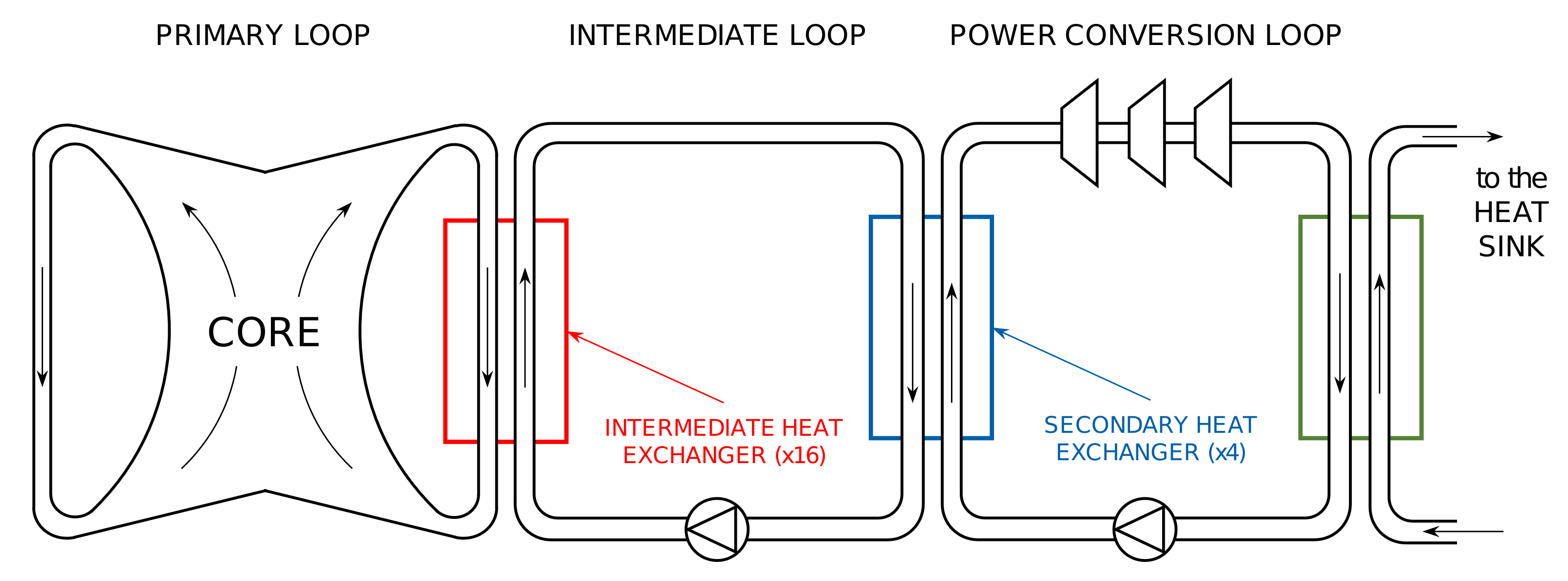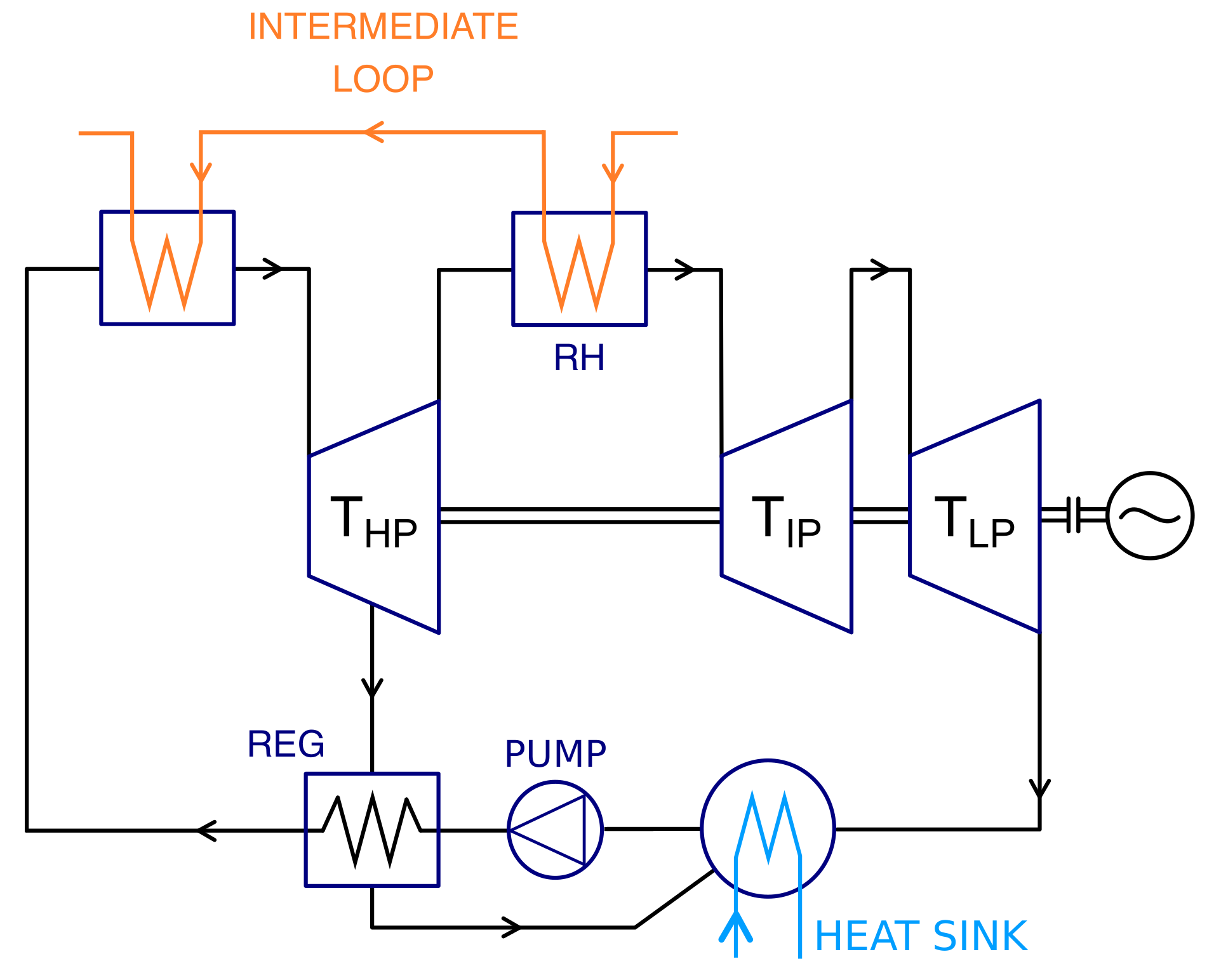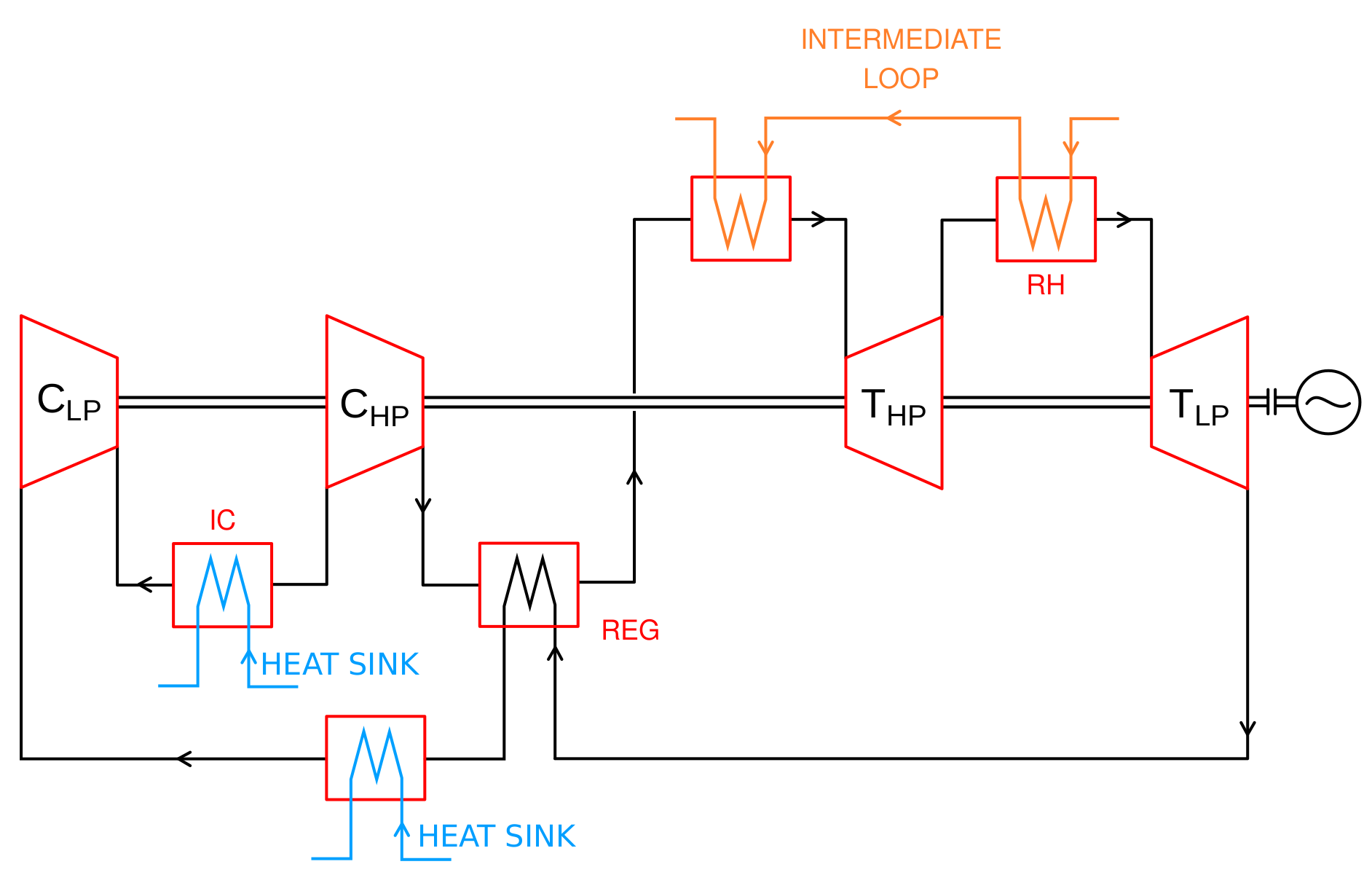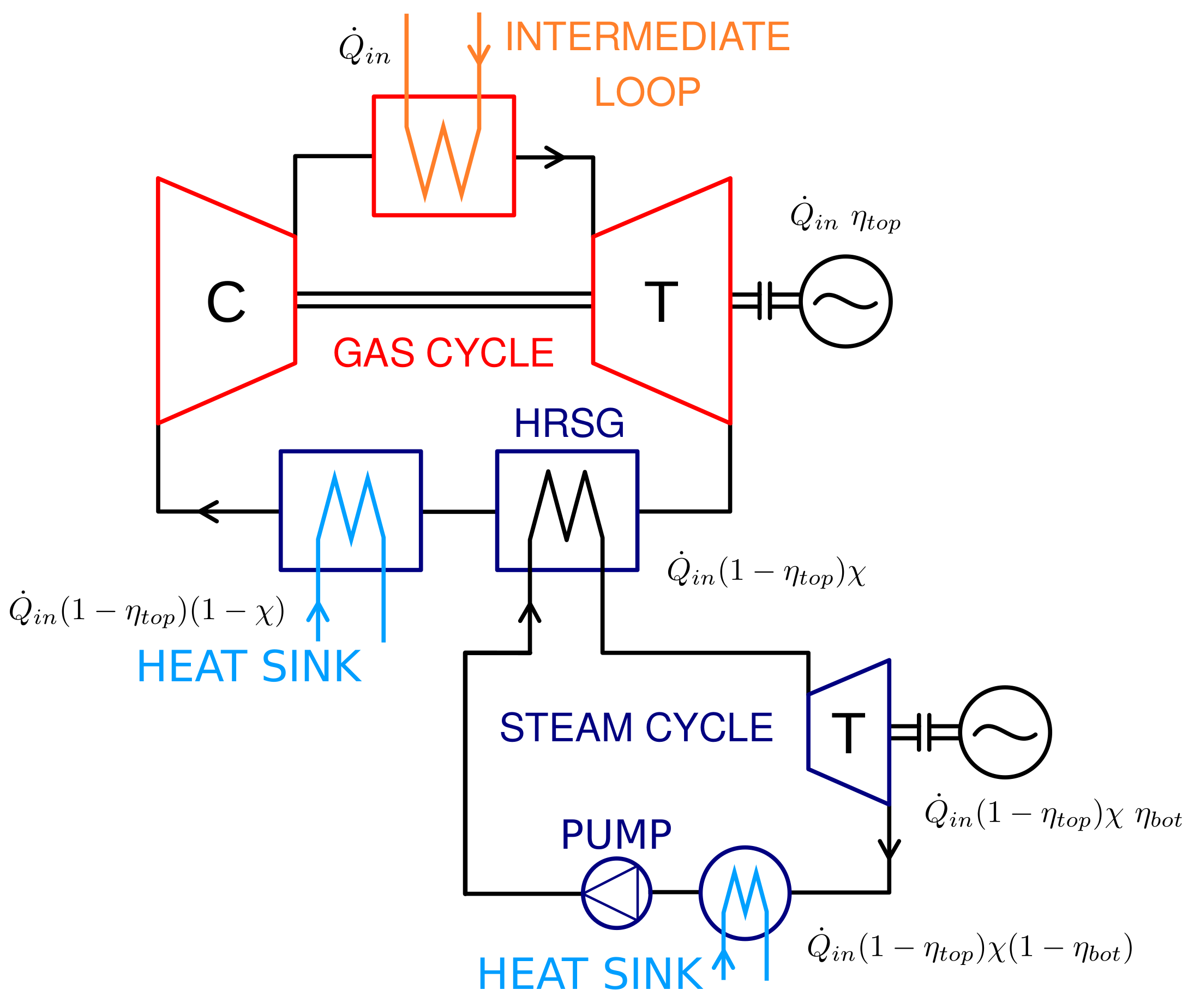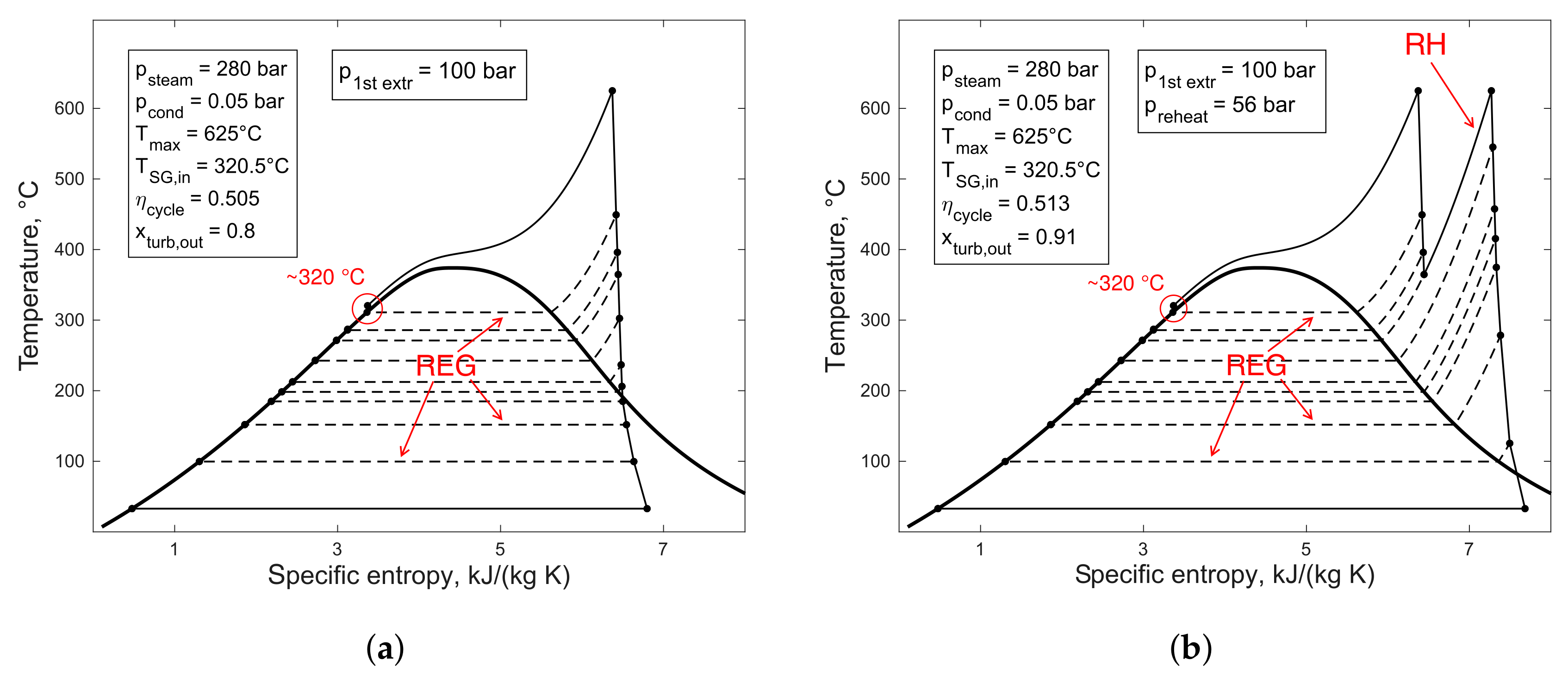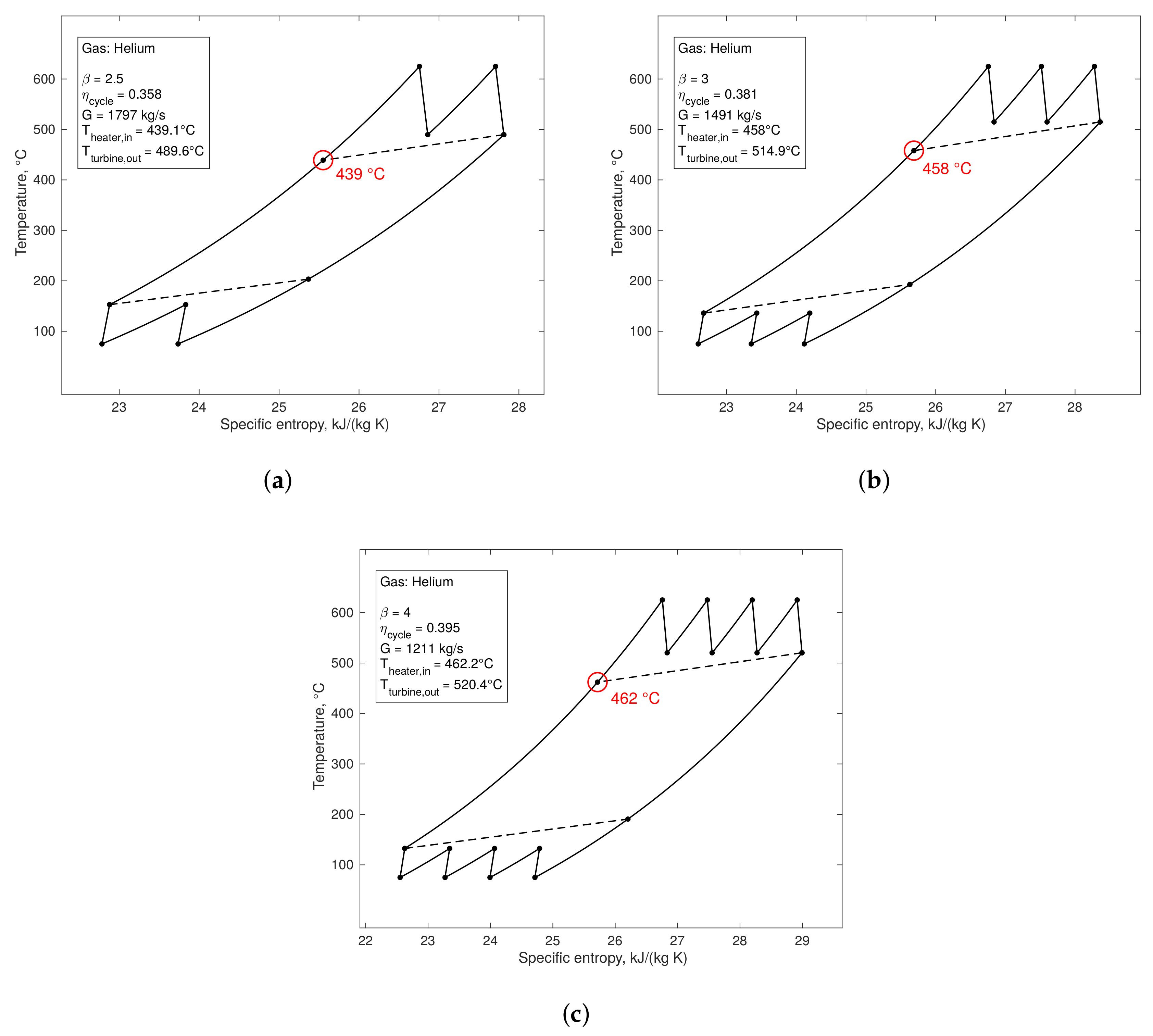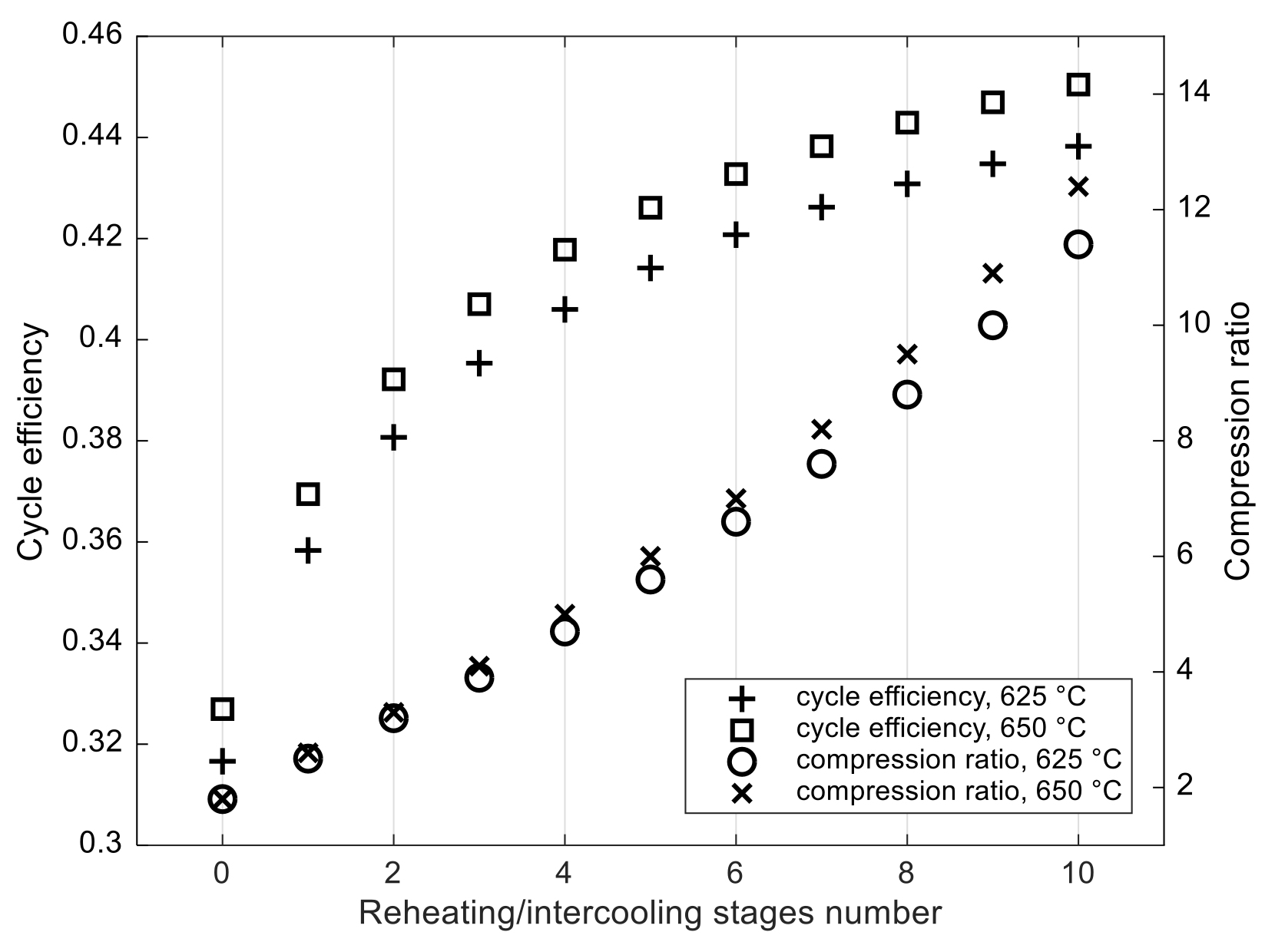1. Introduction
The molten salt fast reactor (MSFR) is one of the reactor concepts within the framework of the Generation IV International Forum [
1]. What makes molten salt reactors (MSRs) peculiar with respect to conventional water reactors and other next generation reactor concepts is the employment of a liquid fuel. The molten salt, therefore, serves both as fuel and coolant, with enhanced safety and thermodynamic performance thanks to the absence of solid fuel elements within the core and to the low operating pressures. This comes at the cost of new challenges to be addressed, e.g., due to the adoption of non-conventional fluids, the presence of distributed internal heat generation [
2] and substantially new dynamics and control features. Many of such technical issues involve the design of plant components, such as heat exchangers and power conversion systems. Additional challenges stem from the need to limit the total fuel salt inventory and to prevent the solidification of molten salts in the coldest regions of the primary and intermediate loops (
Figure 1). The conspicuous power density of the MSFR and its compactness requirements represent relevant technical challenges, as demonstrated by the thermal issues involved in the design of the intermediate heat exchangers [
3]. The characteristics of the MSFR core require the adoption of advanced heat transfer solutions to ensure large exchange surfaces in small volumes and acceptable pressure drops. Passive safety and natural circulation features impose even more severe requirements [
4].
Despite the general renewal of interest in molten-salt-fuelled reactors, little effort has been made so far in the study of out-of-core MSFR subsystems. Given the compactness requirements of the reactor core and the properties of the proposed fuel salt mixtures, heat transfer and energy conversion are expected to play critical roles in the overall design of the plant. This work aims at a preliminary but quantitative analysis of thermodynamics aspects which are relevant to the design of the MSFR plant, with a focus on the analysis of the energy conversion system. The results of the present work can prove useful as reference data in the context of the ongoing studies on the design of the MSFR. Despite the focus on the MSFR as a most representative MSR technology [
1], no intrinsic differences in terms of energy conversion performance should be expected between fast and thermal spectrum MSRs. The outcome of the analysis can therefore apply to MSR systems in general, provided that molten salt coolant properties and attainable temperatures are comparable to the ones here considered.
Three different thermodynamic cycles are considered, i.e., the supercritical steam cycle, the closed helium cycle and the helium/steam combined cycle. The supercritical steam cycle has not yet been employed in the nuclear industry [
5], but is state-of-the-art technology in coal-fired high-temperature power generation [
6]. Recent advancements include the integration of mature steam plant technology with CO
2 capture [
7] and thermal energy storage [
8]. Helium cycles have been a major choice in the nuclear industry for gas-cooled reactors [
9], while non-nuclear applications of helium-based gas cycles are far less common. Closed cycles based on other working fluids, such as air, nitrogen and supercritical CO
2, have been considered for a wider range of power applications, including fossil fuels, concentrated solar power, biomass and waste heat [
10]. On the other hand, air-based open cycles are the reference technology in gas-fired power plants [
11]. Combined cycles are nowadays the most diffuse and efficient energy conversion technology for conventional power applications [
12], in the standard air/steam configuration. Nuclear applications of combined cycles were the subjects of a recent investigation [
13]. The proposed applications include small modular reactors (SMRs) [
14] and high-temperature reactors for combined electricity/hydrogen production [
15]. Helium/steam cycles for molten salt applications have not been investigated so far. Being that the focus of this study is also on the thermal coupling between molten salts and the working fluids of energy conversion systems, the combined cycle constitutes, despite its complexity in relation to the specific field of application, a promising choice in view of the combined benefits of molten salt/helium coupling and better thermodynamic performance with respect to simple gas cycles.
Even though a substantial improvement in terms of thermodynamic efficiency with respect to conventional light water reactors (LWRs) is expected, in the literature no thorough analysis has been yet performed to compare different technologies and to identify possible critical aspects related to the application of established or innovative power conversion technologies to the MSFR concept. The aim of the present work is therefore to propose preliminary designs for the three considered cycles, based on common design assumptions and reasonable parameter values. Results are compared in terms of achievable efficiencies and thermal compatibility between molten salt melting point and working fluid temperatures.
The paper is organised as follows.
Section 2 contains the descriptions of data, models and assumptions employed in the study: The main design data of the MSFR (
Section 2.1) which are adopted as the reference; a brief discussion on the choices of temperature parameters for the intermediate loop (
Section 2.2), which ultimately define the heat source for the energy conversion system; and the three considered cycles (
Section 2.3). For each of them we illustrate the main design assumptions and list the adopted design parameters. Results of the analysis are reported in
Section 3.
Section 4 contains a comparative discussion of the results, along with conclusive remarks and suggestions for further study.
4. Conclusions
The analysis we performed provided a preliminary design of the energy conversion system. The considered thermodynamic cycles allow a sensible efficiency improvement with respect to the performance of conventional light water reactors. In the temperature range typical of the molten salt fast reactor, the supercritical steam cycle shows the best performance, with achievable cycle efficiencies in line with state-of-the-art steam power plants. The helium cycle suffers from relatively low cycle temperatures, showing worse efficiencies (around 40%). Even though increasing the number of stages should allow for better efficiency, the introduction of several reheating stages is unrealistic, so that with the adopted reference parameters, cycle efficiencies higher than 40% are hardly achievable. Furthermore, the incremental efficiency improvement decreases as stages are added. Thermodynamic performance could be further degraded, should the technological feasibility of pure helium gas turbines impose the adoption of different working fluids. The combined cycle also suffers the limitations imposed by the heat source, and suggests intermediate performance for applications of this kind.
The results highlight the critical issue of molten salt freezing within the secondary heat exchangers, due to the relatively low inlet temperatures of the working fluids in the case of a water/steam cycle. Feedwater inlet temperatures of modern steam plants reach values not higher than about 320 °C, leading to severe issues in the design of the steam generators. The adoption of state-of-the-art steam technology would thus pose severe technical limitations due to the freezing temperatures of molten salts. Gas cycles, on the other hand, by operating with compressible fluids and with a high degree of regeneration, can reach inlet temperatures around 450 °C, ensuring better compatibility with the freezing points of the intermediate salts. The helium/steam combined cycle ensures gas inlet temperatures which are more similar to the ones of simple gas cycles. This aspect, in combination with the intermediate thermal efficiencies shown, makes its employment for molten salt applications promising.
Further study will be needed to assess the overall plant efficiency, and the sensitivity to system parameters such as reactor or intermediate circuit temperatures. Parameter sensitivity and optimisation constitutes, in fact, a critical tool in the design of the MSFR plant, given the complex feedback relationship between thermal design and other crucial reactor design aspects, such as neutronics and dynamics. A more detailed analysis of secondary heat exchangers is also needed, as the freezing issue appears as one of the most limiting factors in the overall design of the plant. Mitigation of risks related to freezing is relevant not only to the MSFR, but also to other industrial applications of molten salts, such as concentrating solar power (CSP) [
25]. Other salt compositions, such as chlorine-based ones, might offer better possibilities of overcoming such limitations thanks to lower melting points. Alternative solutions such as supercritical CO
2 cycles [
26] could be considered as well for future investigations.
Other peculiar aspects of MSRs have not been considered in this analysis, which might, however, affect the choice of the heat conversion technology and the design of related subsystems. One major issue is represented by the production, migration and removal of tritium within molten salt mixtures. Most of salt mixtures considered for MSR applications produce tritium under irradiation due to the presence of lithium, which is often used to reduce the melting points. Even though the enrichment in
7Li has been proposed to mitigate tritium production, its buildup, migration and release to the environment still represent a serious challenge. The fact that heat exchangers present the largest surface area fraction of a reactor, and the temperature differences between the intermediate circuit and the heat sink suggest that preferential buildup may occur in the working fluid of the energy conversion system [
27]. This might offer an effective trapping and removal strategy when closed cycles are adopted. In the cases of steam cycles, however, contamination of water would make the separation task particularly challenging, and alternative tritium control strategies would be preferred—e.g., trapping in the intermediate salt or use of migration barriers. Despite being out of the scope of this work, tritium control must therefore be taken into account in the design of the energy conversion system and is a relevant subject for future studies.
